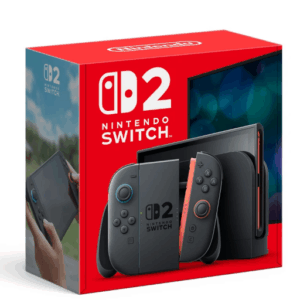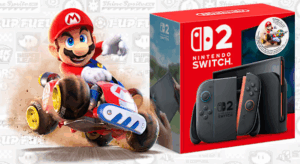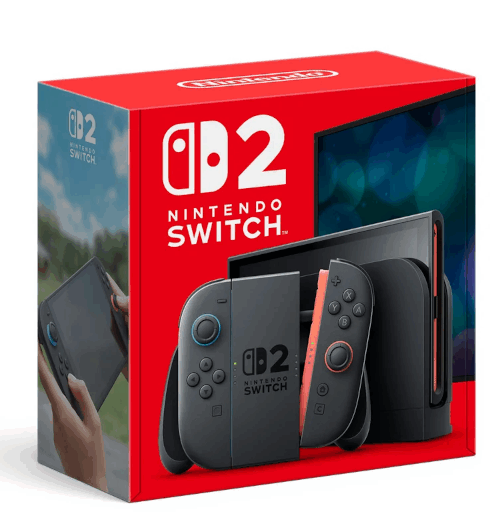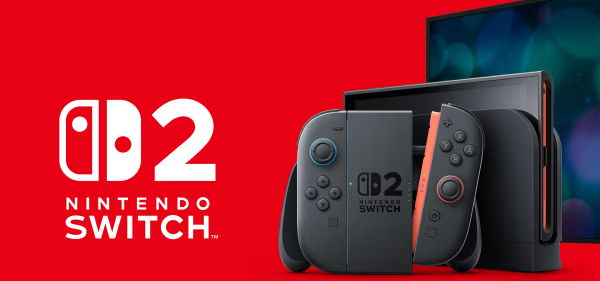Nearly a month has passed since Nintendo’s highly anticipated Switch 2 launched on June 5th, 2025, and after extensive hands-on testing, it’s clear that Nintendo has delivered a worthy successor to their revolutionary hybrid console. The Switch 2 doesn’t reinvent the wheel. Instead, it perfects the formula that made the original Switch a global phenomenon.
Design and Build Quality
The Switch 2 maintains the iconic hybrid design philosophy while addressing many of the original’s limitations. The most immediately noticeable improvement is the substantially larger 7.9-inch LCD display, a significant upgrade from the original’s 6.2-inch screen. Despite the increased screen real estate, Nintendo has managed to keep the overall thickness identical to the original Switch at 0.55 inches, though the device is naturally wider to accommodate the larger display.
The build quality feels premium throughout. The new magnetic Joy-Con 2 connectors represent a major improvement over the original’s rail system, providing a more secure connection while maintaining the satisfying “snap” when attaching controllers. The magnetic system also eliminates the wear-and-tear concerns that plagued some original Switch units over time.
Display and Performance
The Switch 2’s display capabilities represent perhaps the most significant leap forward. In handheld mode, the 1080p screen with HDR support delivers vibrant, detailed visuals that make games truly pop. The 120Hz refresh rate support in handheld and tabletop modes creates buttery-smooth gameplay experiences, particularly noticeable in fast-paced titles like the launch exclusive Mario Kart World.
When docked, the Switch 2 outputs genuine 4K resolution at 60Hz, finally bringing Nintendo’s console gaming into the modern high-definition era. The visual fidelity improvements are immediately apparent when playing enhanced versions of existing games or new titles designed to take advantage of the hardware’s capabilities.
The internal storage has been significantly expanded to 256GB, addressing one of the original Switch’s most criticized limitations. The support for microSD Express cards up to 2TB ensures that digital game collectors won’t face storage constraints anytime soon.
Joy-Con 2 Controllers
 The new Joy-Con 2 controllers feel more substantial and refined than their predecessors. The magnetic connection system provides peace of mind during intense gaming sessions, and the controllers themselves feature improved button responsiveness and enhanced haptic feedback. The analog sticks appear to use more durable components, though only time will tell if they address the infamous drift issues that affected original Joy-Con controllers.
The new Joy-Con 2 controllers feel more substantial and refined than their predecessors. The magnetic connection system provides peace of mind during intense gaming sessions, and the controllers themselves feature improved button responsiveness and enhanced haptic feedback. The analog sticks appear to use more durable components, though only time will tell if they address the infamous drift issues that affected original Joy-Con controllers.
The introduction of the “C button” on each Joy-Con adds new input possibilities, and early games are already finding creative uses for this additional control option. The controllers maintain compatibility with existing Joy-Con accessories while introducing new features that enhance the overall gaming experience.
Backwards Compatibility: A Mixed Success
Nintendo’s commitment to backwards compatibility deserves both praise and scrutiny. The vast majority of the original Switch’s library works seamlessly on the Switch 2, with many titles receiving automatic performance improvements thanks to the more powerful hardware. Games that struggled with frame rate issues or resolution scaling on the original Switch often run significantly better on the new system.
However, the backwards compatibility story isn’t perfect. As of launch, certain titles like Nintendo Labo VR Kit are incompatible due to the Switch 2’s larger physical dimensions. Additionally, some third-party games have experienced minor compatibility issues, though Nintendo has been proactive in releasing updates to address these problems. The company has already pushed fixes for over 20 titles, demonstrating their commitment to maintaining library compatibility.
The software emulation solution Nintendo has implemented for backwards compatibility is generally impressive, with most games running at their intended performance levels or better. Some titles even receive unexpected benefits, such as more stable frame rates and reduced loading times.
Game Library and Launch Titles
 The Switch 2 launched with a solid lineup of exclusive titles, headlined by Mario Kart World, a worthy successor to Mario Kart 8 Deluxe that showcases the system’s technical capabilities. The game runs at a locked 120fps in handheld mode and displays stunning 4K visuals when docked, providing an excellent demonstration of what the hardware can achieve.
The Switch 2 launched with a solid lineup of exclusive titles, headlined by Mario Kart World, a worthy successor to Mario Kart 8 Deluxe that showcases the system’s technical capabilities. The game runs at a locked 120fps in handheld mode and displays stunning 4K visuals when docked, providing an excellent demonstration of what the hardware can achieve.
Beyond exclusive titles, the backwards compatibility means that Switch 2 owners have immediate access to an enormous library of games. Enhanced versions of popular titles like The Legend of Zelda: Tears of the Kingdom and Super Mario Odyssey take advantage of the improved hardware to deliver better performance and visual fidelity.
Third-party support appears strong, with major publishers already announcing enhanced versions of existing games and new titles designed specifically for the Switch 2’s capabilities. The improved processing power opens doors for more demanding ports that weren’t feasible on the original hardware.
Pros
Superior Display Technology: The 7.9-inch 1080p screen with HDR support provides exceptional handheld gaming visuals, while 4K docked output finally brings Nintendo into the high-definition console era.
Improved Build Quality: The magnetic Joy-Con connection system and overall construction feel more premium and durable than the original Switch.
Enhanced Performance: Significant improvements in processing power enable better frame rates, reduced loading times, and support for more demanding games.
Expanded Storage: The 256GB internal storage and support for large capacity microSD Express cards eliminate storage concerns for most users.
Strong Backwards Compatibility: The vast majority of original Switch games work seamlessly, often with improved performance.
Refined Control Experience: Joy-Con 2 controllers feel more responsive and substantial, with improved haptic feedback and the addition of C buttons.
Cons
Limited Revolutionary Features: While the improvements are welcome, the Switch 2 feels more like a significant upgrade than a revolutionary leap forward.
Backwards Compatibility Issues: Some games remain incompatible or have minor issues, requiring ongoing updates and patches.
Battery Life Concerns: The larger, higher-resolution display and more powerful hardware impact battery life, though Nintendo hasn’t released official figures yet.
Price Point: At launch, the Switch 2 carries a premium price that may be prohibitive for some consumers, especially those who recently purchased an original Switch.
Joy-Con Durability Questions: While the new controllers feel improved, it’s too early to determine if they’ve fully addressed the drift issues that plagued the originals.
Final Verdict
The Nintendo Switch 2 represents exactly what longtime fans hoped for: a refined, more powerful version of the beloved hybrid console that addresses most of the original’s limitations without losing its essential character. The improved display, enhanced performance, and robust backwards compatibility create a compelling upgrade path for existing Switch owners while offering newcomers the best possible entry point into Nintendo’s ecosystem.
Is it revolutionary? No. But it doesn’t need to be. The Switch 2 perfects a formula that was already excellent, delivering meaningful improvements across the board while maintaining the magical hybrid experience that made the original Switch so special. For Nintendo fans and portable gaming enthusiasts, the Switch 2 represents the current pinnacle of handheld gaming technology.
The system isn’t without flaws, backwards compatibility hiccups, battery life concerns, and the premium pricing give some pause. However, these issues are minor compared to the substantial improvements Nintendo has delivered. After nearly a month of use, the Switch 2 feels like the console the original Switch always aspired to be.


